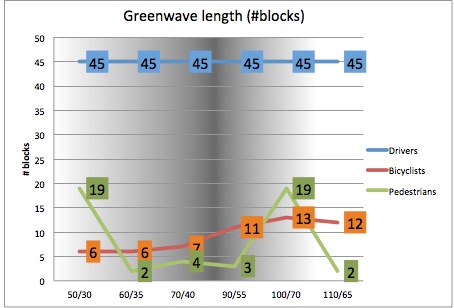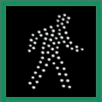Deep into the Green Wave plan, DOT is proposing a design change which will have a profound impact on our culture and our streets and that mercifully the main press missed: ” Implement and review “Bicycle Progression” at one location in 2019 and identify other corridors for implementation in 2020. This signal timing strategy, often referred to a “bicycle green wave,” turns traffic signals along a street to green at cyclists speeds to discourage vehicular speeding, reduce cyclist travel time and stopping, and encourage steady bicycle speeds.”
Everyone is familiar with the green wave concept where traffic lights are timed to allow cars to get a green signal at successive intersections and not break constantly to stop. That may explain – in part – why cars generally respect red lights. But what if the vehicular green wave forces pedestrians and cyclists to stop every 200ft? DOT proposes to adjust the Green Wave to incorporate bicycle timing instead of only considering car timing.
 In 2018 CHEKPEDS, with the help of advocate Joe Realmutto, built a model to optimize the green wave for cars, cyclists and pedestrians, and shared it with DOT. It shows that bicycles could have a 14-block green wave without negative impact on the car’s green wave. Read the full description
In 2018 CHEKPEDS, with the help of advocate Joe Realmutto, built a model to optimize the green wave for cars, cyclists and pedestrians, and shared it with DOT. It shows that bicycles could have a 14-block green wave without negative impact on the car’s green wave. Read the full description
Pedestrians often complain that bicyclists run the red lights (never mind that adventurous pedestrians ignore the “Do Not Walk” sign all the times!). The question should be why? Is it cultural or is it a design flaw? DOT’s proposal implies that there is a design flaw, and they plan to remedy it .
The impact of this change could not be more potent: our efforts to reclaim the city from automobiles is very focused on capturing space but also include more time for pedestrians to cross the road, lower speed so more time to break, and separate times for cars to turn and conflict with pedestrians and bicycles.
An obscure physicist’s theory is that one person’s interval of space is another person’s interval of both time and space, and one person’s interval of time is also another person’s interval of both space and time. Thus, space and time are effectively interchangeable, and fundamentally the same thing (or at least two different sides of the same coin).
DOT intends to roll out a red carpet of green lights for cyclists that was – up to now- reserved for drivers. This is a giant step toward equality, where the rights of bicyclists to ride unencumbered are recognized as being as important as drivers’ rights.
It will also reduce the frequency of red light infractions and could very well have a positive effect on relations between cyclists and pedestrians. This will change the system in depth and – best of all, such changes are invisible and harder to reverse. All Good !
